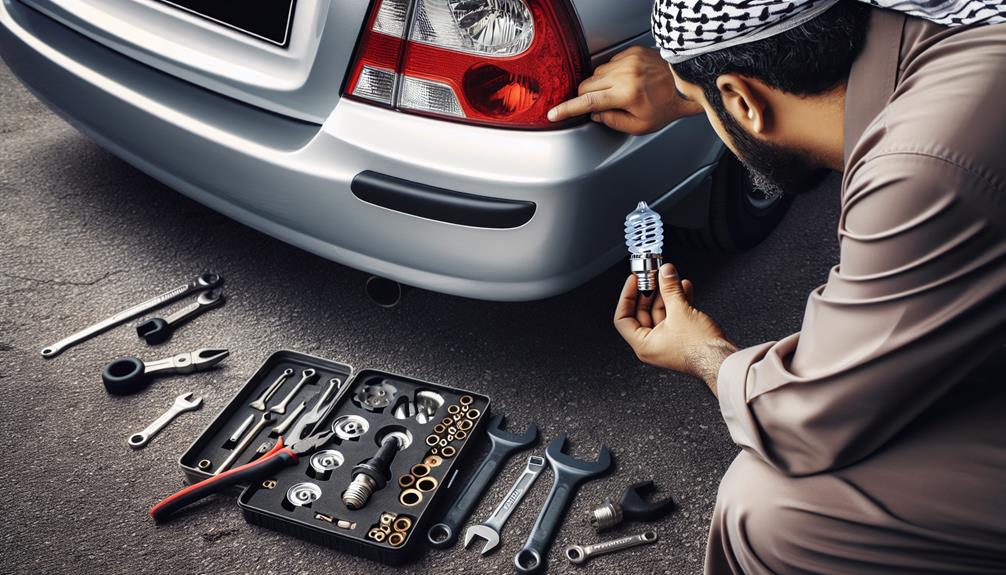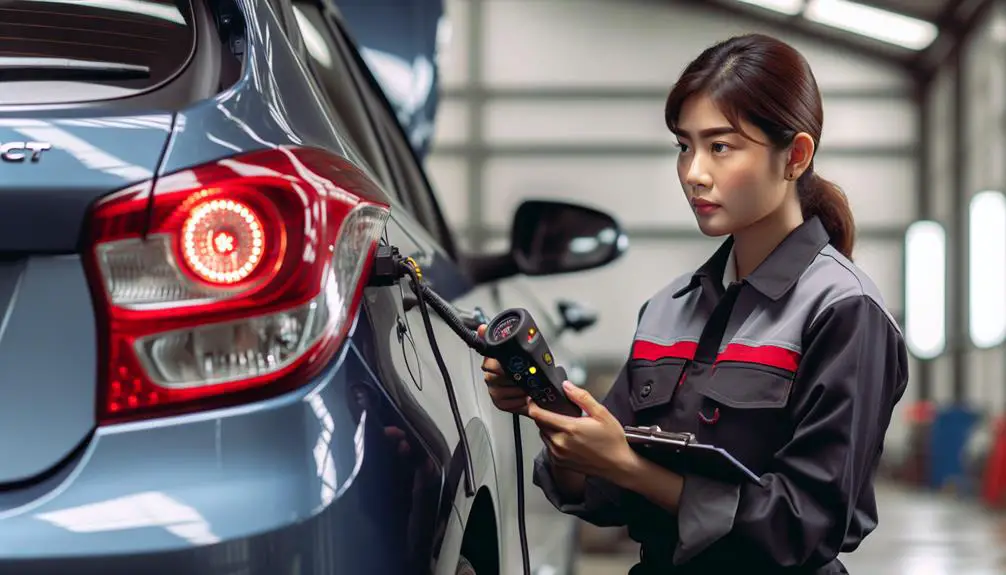Troubleshooting Hyundai Accent brake lights involves several steps:
- Checking the fuse box: Start by locating the fuse box in your Hyundai Accent. Look for any blown fuses related to the brake lights and replace them if necessary.
- Inspecting the brake light switch: The brake light switch is usually located near the brake pedal. Make sure it is working correctly by testing its functionality.
- Examining the wiring and connections: Check the wiring leading to the brake lights for any signs of damage or corrosion. Also, inspect the connections to ensure they are secure and free of debris.
- Testing the brake lights: After completing the above steps, test the brake lights to see if the issue has been resolved. If they still don't work, further diagnosis may be needed.
Checking the Bulbs

Dance diving into more complex troubleshooting, it's essential to initially check if the issue lies with the brake light bulbs themselves. If you're facing a problem with your Hyundai Accent's brake lights not working, starting with the bulbs is a logical initial step. It's a simple check that you can do on your own, saving you time and possibly unnecessary trips to the mechanic.
First, you'll need to guarantee your Accent is parked on a level surface and turned off. Open the trunk or access the brake light assembly from the rear of the vehicle. You're looking for any signs of damage or wear on the bulbs. If you're not sure how to access the brake light bulbs, your car's manual can provide model-specific guidance.
Once you've located the bulbs, check if they're burnt out. This is often the most common reason for brake lights failing to illuminate. A burnt-out bulb will usually have a dark, smoky appearance or a broken filament. If you find that one or more bulbs are indeed burnt out, replacing them is your next step. Make sure you purchase the correct type of bulb for your Hyundai Accent. Incorrect bulbs can cause further issues.
Replacing a brake light bulb is generally straightforward. Remove the faulty bulb by gently twisting it counter-clockwise and then insert the new bulb by twisting it clockwise until secure. After replacing the bulbs, it's essential to test the brake lights to guarantee they're working correctly. Have someone press the brake pedal while you check the lights from the rear, or use a reflective surface like a garage door to see for yourself.
Fuse Box Troubleshooting
After checking the brake light bulbs, the next step is to troubleshoot the fuse box in your Hyundai Accent if the issue persists.
To start, you'll need to locate the fuse box. In most Hyundai Accents, it's found on the driver's side, near the dashboard, or under the hood. Once you've found it, remove the cover. You're looking for the fuse that controls the brake lights. Your owner's manual can help you identify the correct one, often labeled as 'STOP' or 'BRAKE.'
Next, inspect the fuse. If it's blown, the metal strip inside will be broken. This is a clear sign you need a replacement. But don't just replace it with any fuse. Make sure you use one with the same amperage rating to avoid any further issues. Fuses are inexpensive and easy to replace, so this could be a quick fix to your problem.
However, if the fuse looks intact, don't stop there. Sometimes, a fuse can appear fine but still be faulty. To be certain, you can use a multimeter to test the fuse for continuity. If there's no continuity, replace the fuse irrespective of how it looks okay.
To end, after replacing a faulty fuse, it's important to figure out why it blew in the first place. A recurring issue could indicate a deeper problem, but remember, we're focusing on the fuse box right now. Once you've replaced a bad fuse, give your brake lights a test. If they're still not working, you might need to delve deeper into other potential causes, but you've successfully ruled out a simple fuse issue.
Wiring and Connections

If your Hyundai Accent's brake lights still aren't working even after replacing a blown fuse, it's time to examine the wiring and connections.
You'll want to start by inspecting the wiring harness that leads to the brake lights. Look for any signs of wear, tear, or damage. It's not uncommon for wires to get pinched, frayed, or corroded over time. If you spot any damaged wires, they'll need to be repaired or replaced to make sure a proper connection.
Next, check the connections themselves. These are the points where the wires plug into the brake light sockets and the vehicle's main electrical system. Loose or corroded connections can interrupt the electrical flow needed to power your brake lights. Make sure all connections are tight and free from corrosion. If you find any corroded connectors, cleaning them with a wire brush or replacing them entirely might be necessary.
It's also worth looking at the ground connection for the brake lights. A faulty ground can prevent the lights from working correctly. The ground wire is typically attached to the car's frame or body. Make sure it's securely fastened and not corroded. If it looks suspect, cleaning the contact point and re-securing the connection might solve your problem.
Brake Light Switch Issues
Another common culprit behind malfunctioning brake lights on your Hyundai Accent is a faulty brake light switch. This switch is a critical component that signals your brake lights to turn on whenever you press the brake pedal. It's typically located near the top of the brake pedal arm, making it relatively easy to access for inspection or replacement.
If you're experiencing issues with your brake lights not illuminating, it's worth checking the brake light switch. Over time, this switch can wear out or become misaligned, preventing it from functioning correctly. You might notice that your brake lights either stay on all the time or don't turn on at all. In some cases, you might hear a clicking sound when pressing the brake pedal, indicating a potential issue with the switch.
To diagnose a faulty brake light switch, you'll need to locate it and visually inspect it for signs of wear or damage. If the switch appears damaged or out of position, it's likely the source of your problem. You can test the switch with a multimeter to check for electrical continuity. If the switch doesn't have continuity when the brake pedal is pressed, it's time to replace it.
Replacing a brake light switch is a task you can typically do yourself with basic tools. Make you disconnect the battery before starting to avoid any electrical mishaps. After installing the new switch, make sure it's properly aligned and adjusted so that it activates the brake lights at the correct time. With a new switch in place, your brake lights should work reliably, keeping you safe on the road.
Professional Diagnosis Options

Consulting a professional's help for diagnosing your Hyundai Accent's brake light issues guarantees accurate identification and repair of the problem. If you're not comfortable tinkering with your car's electrical systems or haven't found a solution through basic troubleshooting, it's time to contemplate expert assistance.
Your local Hyundai dealership is a prime option. They've got technicians specifically trained on Hyundai models, ensuring they're familiar with common and obscure issues alike. Plus, they'll have the right diagnostic tools to pinpoint the problem quickly. However, keep in mind that dealership services can come at a premium cost.
If you're looking for a more budget-friendly option, independent auto repair shops are worth contemplating. Look for shops with good reviews and ask if they've experience with Hyundai vehicles or brake systems in general. Many independent mechanics offer quality service at lower prices than dealerships. Just make sure they use quality parts that won't compromise your car's safety or functionality.
For those who prefer a more hands-off approach, mobile mechanics are a convenient choice. They can come to your location, saving you the trouble of driving to a shop with potentially faulty brake lights. This option combines the expertise you need with the convenience you want, often at competitive prices.
Conclusion
In summary, if your Hyundai Accent's brake lights aren't working, start by checking the bulbs and then move on to the fuse box.
Don't overlook the wiring and connections, as these can often be the culprit.
If everything else looks good, the issue might lie with the brake light switch.
If you're still stuck, it's best to seek a professional diagnosis.
Remember, ensuring your brake lights work properly is important for your safety on the road.